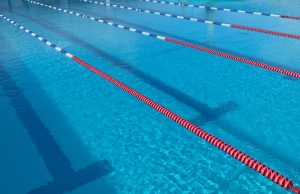By Jonathan Duffy, Arctic Meta
Iceland is known for its incredible nature, volcanic activity and happy people, but it’s also known for having weather that’s a bit all over the place.
There’s an old Icelandic saying, “if you don’t like the weather, just wait ten minutes.” If you spend an extended period here, you will see why.
In a single day you can experience sunshine, rain, hail, snow, wind, some more sunshine, and the Northern Lights later in the evening.
The weather can change very quickly, but like other places in the world, there can be days where going outside is just not an option.
So you’ve come all this way, and it’s a rainy day, not to worry, I have you covered. Below are 12 of the best activities you can do in Iceland when the weather is bad. Read on for more.
12. FlyOver Iceland

Photo: FlyOver Iceland.
If the weather is too bad to visit some of Iceland’s natural wonders, you could choose to fly over them instead.
FlyOver Iceland is a relatively new attraction to the nation’s capital and is the first of its kind. To put it simply, it’s kind of like a mixture between a theme park ride and an IMAX movie.
In this experience, you are safely strapped into a hydraulically controlled seat in front of a spherical screen. A film of flying over some of the most spectacular places in Iceland then begins, and the hydraulic seat mimics the flight’s movements, making you feel as if you are there.
Photo: FlyOver Iceland.
The experience comes complete with other elements like wind, mist and even some of the smells of the Icelandic nature.
Before you embark on the flight, you are also treated to two pre-shows. Both of them are completely different but equally filled with the magic and mystery of Iceland.
I legitimately have paid to experience FlyOver Iceland many times and will probably keep doing so. It’s an experience you really should take part in on a visit here, and you don’t have to wait for the weather to be bad.
11. Eat and Drink Like a Viking

Photo: Kaffibrennslan.
Well, maybe not entirely like a Viking because that might kind of suck. The early settlers of Iceland didn’t have a lot in the way of food and were almost completely wiped out due to famine several times. There is even a recipe for a soup made from moss in the historical records, so times were definitely tough and desperate.
Photo: Kól Restaurant.
Luckily, Iceland could now be considered a food lover’s dream. The capital of Reykjavík is filled with restaurants, cafés and bars.
It’s dark and cold here for many months of the year so having a nice cosy place to enjoy a meal with friends and family is incredibly important to Icelandic people.

Photo: Flatey Pizza.
Café culture is also booming in Iceland. With most venues offering free WIFI to customers, they are bustling hives of activity for most of the day.
Cafés in Iceland are excellent places for people watching. If you spend an hour or two there, you will see everything from tourists planning their day, students cramming for exams, colourful local characters who everyone seems to know, and hipster artists working on some intense project on their laptop as they bop along to massive, oversized, vintage headphones.
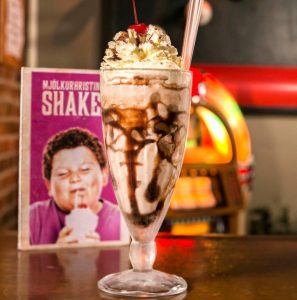
Photo: Lebowski Bar.
There are many places to try some traditional Icelandic food, but Iceland’s food and drink culture has also been heavily influenced by many other nations. Naturally, there are Scandinavian influences, but you can find everything from Asian noodles, Italian pizza, American burgers, and fries to even North African couscous.
10. Visit Harpa Concert Hall

Photo: Harpa Concert Hall.
Chances are, if you have seen images of Reykjavík, you have probably seen Harpa. Sitting on the Reykjavík harbour, this glass cubic structure at times seems to mock the torrent sea.
It was designed by Danish Architecture firm ‘Henning-Larsen’ in collaboration with the Danish-Icelandic artist Olafur Eliasson. It’s mostly made of steel, concrete and glass, and the hexagonal shapes of its walls are inspired by volcanic basalt rock, which forms these shapes naturally.
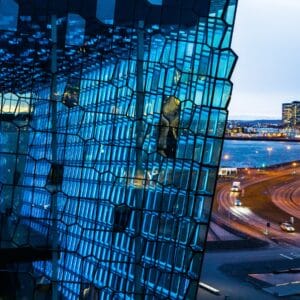
Photo: Harpa Concert Hall.
The story of the building is significant for modern Icelandic history. Construction began in 2007 and then was halted entirely due to the Global Financial Crisis.
The government later stepped in to assist in recommencing the construction, and for a time, Harpa was the only construction project in existence throughout the country.
Harpa was finally opened in May of 2011, and today it is home to the Icelandic Symphony Orchestra and the Icelandic Opera, among other tenants.
For many locals, Harpa is where they come to see international performers. Many big-name comedians have graced the stage here, like Gabriel Iglesias, Jimmy Carr, Kathy Griffin, Hannah Gadsby and Bianca Del Rio.

You don’t have to be seeing a show to visit Harpa – entrance to the impressive building is free, and it can be a fantastic place to be if the weather is a bit inclement.
Sometimes waves from the sea can crash directly onto the thick glass walls of this incredible structure which, if you get a bit of a thrill from storms, is genuinely breathtaking.
9. Take a tour of a Brewery or Distillery.

Photo: Barion Bryggjan Facebook Page.
When people think of Iceland, they most likely think of the rotting shark meat and a drink called ‘black death’ that could strip paint, and yes, these two things are here and easy to get a hold of, but as far as booze goes, there’s a lot more Iceland has to offer.
Beer is arguably the most popular alcoholic drink in Iceland, and the Icelandic love affair with this frothy brew is a story that’s almost Shakespearean in magnitude. You see, beer was banned in Iceland for more than 70 years.

Photo: Frederiksen Ale House Facebook Page.
In 1915 the government held a referendum, and the result was a complete ban on all alcoholic beverages. This ban was lifted on wine in 1922 when the Spanish basically said they wouldn’t buy Icelandic fish if Iceland didn’t buy their wine.
In 1935, spirits were once again legalised, but beer remained illegal until March 1st 1989, a day now celebrated every year as ‘Beer Day.’
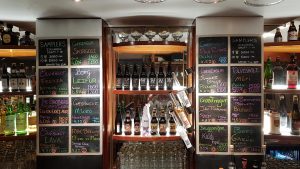
Photo: Microbar Facebook Page.
Since then, Icelanders have more than made up for lost time, and there are now breweries all over the country.
If you enjoy beer and haven’t tried an Icelandic ale, you won’t be disappointed. Icelandic beers are all made with fresh, clean Icelandic water, which any local will tell you is the ‘cleanest water in the world,’ and helps create an incredible flavour.
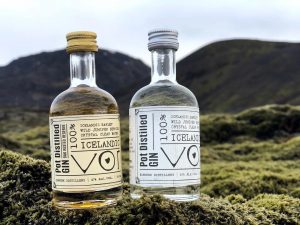
Photo: Eimverk Distillery Facebook Page.
If the weather turns bad, a trip to a brewery to take a tour and find out how it’s all made is a great way to pass the time and sample some local tastes.
If you’re not a beer drinker, there are also distilleries around like Eimverk, who make whiskey and gin.
8. Get to know the Whales of Iceland.
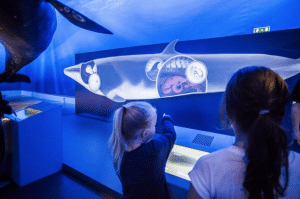
Photo: Whalesoficeland.is.
The waters around Iceland are well known for being a hub of marine life, and people come from all over the world just for the chance to spot a whale in the wild.
Humpbacks, Minkes, Orcas, dolphins and porpoises are just a few of the species you could see on a whale watching tour.
When the weather is bad in Iceland, whale watching can be downright impossible. The ocean’s waves can be unforgiving in a storm, and no tour company is ever going to risk your safety, so if a storm is brewing, you’ll have to stay on ‘relatively’ dry land, but there is an alternative.
In the seaside suburb of Grandi, right next to FlyOver Iceland, is an incredible exhibit that can give you some literal perspective on the gentle giants of the sea, Whales of Iceland.
This venue resulted from a collaboration between the Marine Research Institute of Iceland and a whale watching operator. The result is an interactive, educational space that allows visitors to get a proper aspect of size, shape, colour and habitat when it comes to marine mammals.
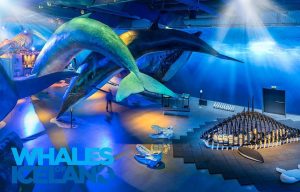
Photo: Whales of Iceland Facebook Page.
The exhibition comprises 23 life-size models of the different whale species found in the waters around Iceland. These include a 25 metre long (82 ft) blue whale and a full-size sperm whale.
Each hand-made model was crafted to match a specific whale in the ocean, right down to individual hand-painted markings.
Guests are invited to wander around the calming, dream-like room and take in the actual size and colour of each whale. You can also touch the models, which isn’t something you usually get to do in a museum.
This experience is particularly great for families.
7. Have a Laugh at a Local Comedy Show

Photo: The Secret Cellar Facebook Page.
Something you might not know about Iceland is that it has a thriving stand up comedy scene.
You might have even seen national treasure Ari Eldjárn on Netflix in his comedy special ‘Pardon my Icelandic’ and thought to yourself, “Now, that’s not necessarily the place I think of when I talk about stand up comedy.”
Culturally, stand up comedy, as most people know it (a person telling jokes in a microphone), is relatively new to Iceland.
The Icelanders have always had their own comedians. Still, it wasn’t until the mid-to-late nineties that the tradition of bashing out a few well-crafted quips rather than character-based or sketch comedy became a thing.

Photo: Local Comedian Kimi Tayler
In 2015, a local comedian called Gísli Jóhann decided he wanted to perform stand up in English, and at the time, there wasn’t a venue for him to do that, so he approached a local bar and asked if he could start an open mic night. The bar agreed, and ‘Golden Gang Comedy’ was born.
The Monday night institution morphed over several years and helped birth some of the best comedians working in Iceland today.

Photo: Local Comedian Hugleikur Dagsson.
There are still comedians who only perform in Icelandic, but there is now a vibrant English Speaking comedy scene in Reykjavík, a city whose inhabitants are Icelanders, tourists and a large population of immigrants for most of whom English is a common language they can share a laugh in.
The Secret Cellar was the first dedicated comedy club, hosting comedy shows every night of the week, so you can always just pop by there and see what’s going on.
There are many regular comedy nights at other venues throughout the city as well, and the easiest way to find them is by doing a Facebook search for events near you.
6. Go to a Live Music Gig

Photo: Gaukurinn Facebook Page.
Icelandic bands have mystified audiences all over the world for years. For many of the bands who make it internationally, we hear their music in films, commercials, and favourite TV shows.
It has often been said that there must be something in Iceland’s glacial water that seems to stir a certain level of creativity that produces incredible musicians.
We’ve all heard of Björk, Sigur Rós, Of Monsters & Men and Kaleo, but we often forget that they didn’t just come out of nowhere. Many of these incredible artists cut their teeth in the live Icelandic music scene.

Photo: Vök Band Facebook page.
Icelanders love music. Once again, it’s most likely a beautiful side effect of having to spend many months in darkness and cold. Icelanders love going to a live gig. The audiences in Iceland are fun, friendly, supportive and, most importantly, interested.
Icelandic music lovers want to know who’s new, what makes them different, and their artistic process. They tend to listen to many musical genres and go check out a live show even if they don’t know anything about the artist.
Iceland has also been the host to some incredible music festivals in the past, which brings thousands of people from all over the world. Because of this, many artists in Iceland are constantly evolving, learning and getting better.
Bars and clubs in Reykjavik are hosts to live concerts all year round, so when the weather has you down, heading to a gig to see someone who just might be the next big thing is a definite solution to soothe the storm blues.
5. Visit Kolaportið Flea Market
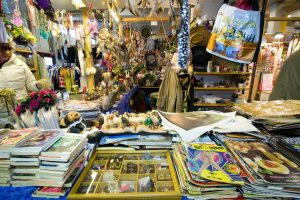
Photo: Kolaportið Facebook page.
You can tell a lot about a place’s people by what they throw away. You can tell even more about them by what they instead choose to re-sell. For this reason, visiting a flea market as a tourist is fascinating.
As someone born on the other side of the world, I had my own ideas of what people sell at a flea market based on my suburban Australian upbringing.
Compared to what I was used to, the first time visiting Iceland’s premier (and only) regular flea market was like I had discovered the attic of the most fascinating grandparents in the world.
Kolaportið sits on the Reyjavík Harbour and is open every weekend from 11 am to 5 pm. It’s uniquely housed in a building rather than outside, which means the unpredictable Icelandic weather will never stop shoppers from finding a bargain.
Inside, you will find a wide variety of items, from fashion to food, books, records, electronics; I once even saw a tuba. You have no idea what you might find there, which is what makes this place so fascinating.

Photo: Kolaportið Facebook page.
Kolaportið is also one of the easiest ways for visitors to Iceland to purchase local crafts directly from the artists. If you’re wanting to pick up an authentic hand-knitted Icelandic sweater (lopapeysa), this is the surest place you will find it.
It’s cheap, it’s authentic, it’s chaotic. It’s everything you want in a flea market.
4. Go to the Pool
Photo: Vesturbæjarlaug Facebook page.
The storm clouds have started brewing, and snow has begun to fall, and almost nobody would ever think that this is the perfect time to go for a swim; nobody except Icelanders.
Iceland is home to over 200 public swimming pools. That’s more pools per head of population than any other country on Earth.
Going to the pool is an important part of Icelandic life. It’s what people do when the weather is good, when the weather is bad, when there’s nothing to do, when they want to relax, or even just meet their friends and hang out.
All public pools in Iceland are filled with geothermal hot water. This means that the temperature of the pool is always pleasant. If you want warmer or colder water, there are always pots with the exact temperature featured on a sign.
Nothing can quite come close to the feeling of being outside while it’s below zero and snowing, but you are perfectly comfortable and toasty warm because you’re in a bath of water that has been heated by volcanic activity.
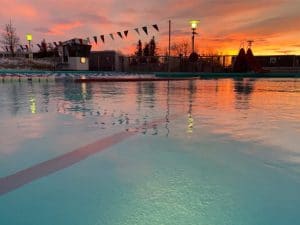
Photo: Vesturbæjarlaug Facebook page.
Public pools in Iceland are easy to find and incredibly cheap to enter.
Icelanders are very protective of their pools, so make sure you follow the rules if you visit. This includes getting undressed and showering naked before you put your bathing suit on. This is so they can limit the amount of chemicals used in the water to keep it clean.
3. Catch a movie

Photo: Bio Paradis Facebook page.
You might not have thought this would be a good idea if you’re travelling in a country where the native language isn’t English, but if the weather turns bad and there’s a flick you would love to see, it’s not a problem.
Unlike many other European countries, Iceland isn’t a ‘dubbing’ nation. Iceland only dubs foreign films that are intended for young audiences like cartoons, but even then, big releases like Pixar films are often available in the dubbed version and the original version.
All movies in English are presented in their original format with Icelandic subtitles.
The major cinema chains in Iceland also have an element of the old days still in place. Movies shown in Iceland still have an intermission halfway through the film. It usually lasts for 15 minutes, which is enough time to go to the bathroom and maybe get a refill on popcorn.
Photo: Bio Paradis Facebook page.
Many who live here don’t love the intermission because it is cut precisely in the middle of the film, which can mean that the film is split in a strange place. If you’re visiting, however, it’s quite a nice novelty.
Iceland also has independent cinemas and several film festivals like the Reykjavík International Film Festival, Frostbiter Icelandic Horror Film Festival, and the Skjaldborg Documentary Film Festival in Patreksfjörður.
2. Visit the Þjóðminjasafnið National Museum
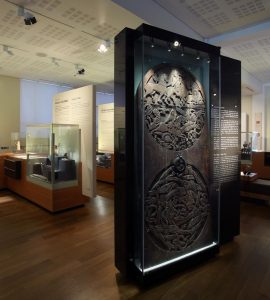
Photo: Thjodminjasafn.is.
The National Museum of Iceland’s name in Icelandic (Þjóðminjasafnið) looks like the worst hand of scrabble you could ever be given, but it’s an essential place to visit for anyone who comes to this tiny island nation in the Atlantic Ocean.
It’s a cheap, informative and effective use of time during bad weather, especially if you have children. The entry price grants you access to all exhibitions. There are temporary exhibits and permanent ones.
The most interesting exhibit for visitors is ‘Making of a Nation – Heritage and History in Iceland.’ This carefully maintained collection of over 2000 artefacts charts the journey of Icelanders from Viking longboats to the modern people they are today.
Every single era of Icelandic history is covered, and often even some Icelanders leave this exhibit saying, “well I didn’t know that?”
1.Relax in the Panorama Glass Lodge
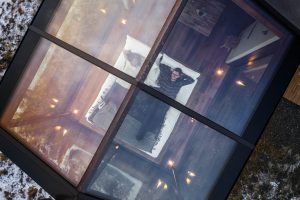
The weather has played an integral role in Icelanders’ lives for so long that they have 46 words for the different kinds of snow in winter. There’s also a unique Icelandic word that describes the type of weather nicer to look at than to be in.
Gluggaveður (Glooka-veth-oor) translates to ‘Window Weather’ and means weather that’s better seen from a window.
There are different kinds of gluggaveður. There’s the kind where there’s blue skies and sunshine, then when you go outside, it’s windy and -10 degrees; but then there’s also the kind where it’s clearly stormy out, but it’s nice to watch from the comfort of a cosy place.
There’s no better place to enjoy window weather than a lodge that has a surplus of windows.
The Panorama Glass Lodges are in the pristine countryside of the South Coast of Iceland. Each lodge has been created with privacy and seclusion in mind so you can get the most out of your stay.
If you are here during the Northern Lights season, these glass lodges will provide you with extreme comfort as you witness the Aurora Borealis from the best possible vantage point, the Icelandic countryside, where there is no light pollution.
You could also choose to gaze out at the magnificent vistas from a private outdoor hot tub. However you decide to use your stay, the Panorama Glass Lodge provides an incredible, comfortable and cosy place to wait out any storm.
Conclusion
Icelanders have had a long time to get used to the weather patterns of the land of fire and ice. As a result, they have developed an easy-going attitude that makes them incredibly adaptable to change. There’s always a plan B in case of bad weather.
Because of all of this, Icelanders also appreciate maintaining activities that can take place indoors and will always continue to innovate and grow to make sure a little bit of rain, snow, hail, wind or volcanic eruption doesn’t ruin a perfect day. In fact, as much as weather patterns can direct your day, as our list shows it’s often just another way to experience some of the best things to do in Iceland.



